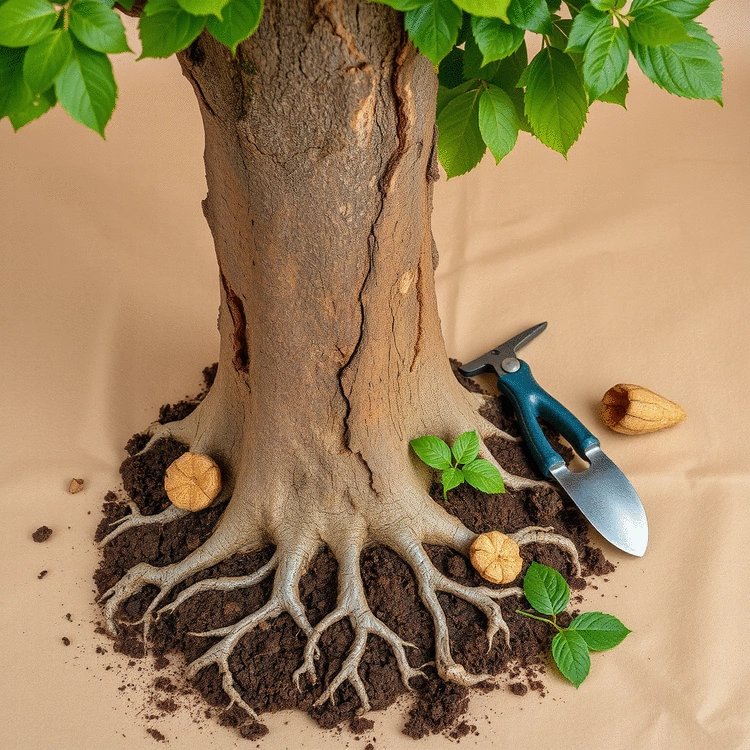
- Root Care
- Sep 03
2025-07-23
In the realm of horticulture, did you ever ponder what exists beneath the surface of your garden? Understanding root diseases is not just about keeping trees healthy; it’s about preserving the entire ecosystem. The battle against these hidden threats begins with knowledge, empowering you to take proactive measures for your trees' well-being.
Understanding the signs and types of root diseases is essential for maintaining tree health. Below are key symptoms and types of root diseases that affect trees.
As a passionate horticulturist, I often reflect on the hidden battles that occur beneath the surface of our gardens. Understanding root diseases is crucial for maintaining tree health, as these invisible threats can significantly affect not just the trees, but the entire ecosystem. By learning how to identify these issues early on, we can take proactive steps to safeguard our trees. For more guidance on overall tree health, consider exploring resources on essential tree care and landscaping.
Root diseases are caused by various pathogens and environmental stresses that compromise the health of a tree’s root system. When we focus on root care, we enhance the vitality of our trees and, as a result, the beauty of our landscapes. In this section, we'll explore how to identify root diseases, the common types that affect our trees, and the environmental factors at play.
Spotting the signs of root disease early can make a significant difference in recovery efforts. Trees may exhibit a variety of symptoms that can help us diagnose root issues. Look for the following common symptoms:
Each of these symptoms can indicate underlying problems that may be affecting your tree's roots. For example, wilting leaves can signal a lack of water reaching the tree, often due to root damage. It's important to observe your trees closely, as early intervention can lead to better outcomes.
Beyond the general symptoms, here are some specific signs to watch for:
If you're noticing any of these symptoms, it's time to investigate further. These indicators can reveal a lot about the health of your tree's roots and the necessary steps to take for recovery. For more information on preventing common root problems, check out our guide on identifying and preventing root rot.
To become more adept at identifying root diseases, visual aids can be incredibly helpful. Diagnostic images can help you recognize symptoms that may not be easily visible at first glance. Consider using resources like online horticultural databases or local extension services that offer images of common root issues.
By familiarizing yourself with these visual cues, you empower yourself to act swiftly and effectively. Next time you’re wandering through your garden, keep an eye out for these signs. Remember, knowledge is your best tool in preventing damage to your beloved trees!
There are several root diseases that can threaten the health of trees. One of the most notorious is Armillaria root rot, which can decimate entire sections of a forest or garden. Understanding the specific types of diseases helps in developing effective management strategies.
Each of these diseases has unique characteristics and effects on the tree. For instance, Armillaria often infiltrates trees through soil-dwelling roots, while Oak Wilt can spread rapidly from tree to tree, making early detection vital. Knowing the kind of disease you're dealing with can guide your response, so it’s essential to stay informed!
Armillaria root rot is a fungal disease that affects numerous tree species, causing decay and eventually leading to tree death. It often manifests with symptoms such as yellowing leaves, premature leaf drop, and stunted growth. What's tricky about this disease is that it can remain dormant in the soil for years, waiting for the right conditions to strike.
If you suspect Armillaria, it’s crucial to take action quickly. Removing infected trees and ensuring proper soil drainage can help prevent the spread of this disease to nearby healthy trees.
Aside from Armillaria, other notable root diseases include Oak Wilt and Bacterial Leaf Scorch. Oak Wilt is a serious condition that can rapidly kill oak trees and is caused by a specific fungus. It spreads through root grafts between trees and can also be transmitted by beetles.
Bacterial Leaf Scorch, on the other hand, causes leaf margins to turn brown, leading to premature leaf drop. Both diseases require prompt attention, and it’s wise to consult with a local expert for effective management plans.
Understanding fungal pathogens is essential for anyone dedicated to tree health. These organisms can invade tree roots, leading to deterioration and disease. Some of the most common fungal pathogens include:
Each of these pathogens has specific environmental conditions under which they thrive, so recognizing the signs of their presence can be beneficial for managing tree health. Remember, knowledge of these fungi can arm you with the tools you need to protect your trees!
Common fungal pathogens often lead to root diseases and can be difficult to control. These pathogens thrive in wet, poorly drained soils, making soil health management vital. If you notice unusual symptoms, it’s critical to identify whether a fungal infection is present, as treatment varies widely.
By keeping a close eye on your trees and understanding the pathogens that may be lurking, you can take proactive steps to ensure their health and vitality.
Mycology, the study of fungi, plays a crucial role in understanding root diseases. It helps us grasp how these organisms interact with trees and the environment. This knowledge can inform our management practices and enhance our strategies for maintaining healthy trees.
As we deepen our understanding of mycology, we can better protect our trees from these unseen threats, ensuring that our gardens thrive for generations to come!
The environment plays a significant role in the health of tree roots. Factors such as soil composition, moisture levels, and even nearby vegetation can influence how trees respond to diseases. By maintaining a healthy environment, we create conditions that discourage root diseases.
By focusing on these environmental factors, we can create a thriving ecosystem that supports healthy tree roots. It's all about seeing the bigger picture and recognizing the interconnectedness of our gardens!
Healthy soil is the backbone of a thriving garden. It provides trees with the nutrients they need while also supporting beneficial organisms that help prevent diseases. Regular soil testing and amendments can help maintain soil health, ensuring that your trees receive the best care possible.
In essence, managing soil health is like nurturing the roots of a community—when the foundation is strong, everything flourishes!
Environmental stressors, such as drought or excessive rain, can also take a toll on root health. When trees are stressed, they become more susceptible to diseases. Implementing strategies to mitigate these stressors, like improving soil drainage or adjusting watering schedules, can help protect our trees. For further reading on strengthening tree roots, explore our article on deep roots for stable trees.
As we work together to create healthier environments, we not only support our trees but also foster a deeper appreciation for the balance of nature. Every effort counts!
Did you know? Regularly monitoring your trees for signs of stress, such as wilting or discolored leaves, can help catch root diseases before they become severe. Make it a habit to inspect your trees seasonally, and consider keeping a garden journal to track any changes in their health over time. This proactive approach not only aids in early detection but also fosters a deeper connection with your plants!
When it comes to ensuring the health of our trees, understanding how to diagnose root diseases is crucial. Just like a doctor examines a patient to find the underlying issues, we need to take a closer look at our trees to identify any problems beneath the surface. At Deep Roots Journal, I believe that proper diagnosis leads to effective management and treatment, fostering a thriving ecosystem.
Using the right diagnostic techniques can significantly improve our chances of catching root diseases early. From conducting soil moisture analysis to performing physical root inspections, these methods give us a clearer picture of the health of our trees. Let’s explore these techniques to ensure our trees remain vibrant and resilient!
Understanding soil conditions is vital for tree health. One of the first steps in diagnosing root diseases is assessing soil moisture. Soil that is too dry or too saturated can lead to stress, making trees more susceptible to diseases. Regular checks of soil moisture levels can help us maintain the optimal environment for our trees.
To conduct a soil moisture analysis, follow these simple steps:
Soil health directly affects root vitality. Healthy soil should be rich in organic matter and hold moisture without becoming waterlogged. When we ensure good soil conditions, our trees can access nutrients and water more effectively, which strengthens their resistance to diseases. Remember, a thriving tree starts with nurturing its roots!
A physical inspection is another essential diagnostic technique to assess tree health. This method allows us to see firsthand any visible signs of root disease. By gently digging around the base of the tree, we can inspect the roots for abnormalities, discoloration, or decay.
Here’s how to perform a thorough root inspection:
Aside from visual inspection, consider using tools like root probes. These can help assess the root depth and structure without extensive digging. This non-invasive approach is especially beneficial for preserving the tree's health while gathering necessary information.
In addition to manual techniques, several diagnostic tools can aid in tree health assessments. These tools provide more precise data regarding root diseases, helping us make informed decisions. The right technology can enhance our understanding of tree health significantly.
Some effective diagnostic techniques include:
Identifying pathogens accurately is crucial for effective treatment. If you suspect a specific disease, consider sending samples to a local extension service or university lab. They can perform detailed analyses to identify the root cause and recommend targeted interventions.
By utilizing these diagnostic techniques, we can catch root diseases early and take the necessary steps to protect our trees. Remember, at Deep Roots Journal, I’m here to support you in every step of your horticultural journey. Together, we can cultivate a thriving natural environment that benefits both trees and the ecosystem! You might also find our article on encouraging healthy root development helpful.
Here is a quick recap of the important points discussed in the article:
